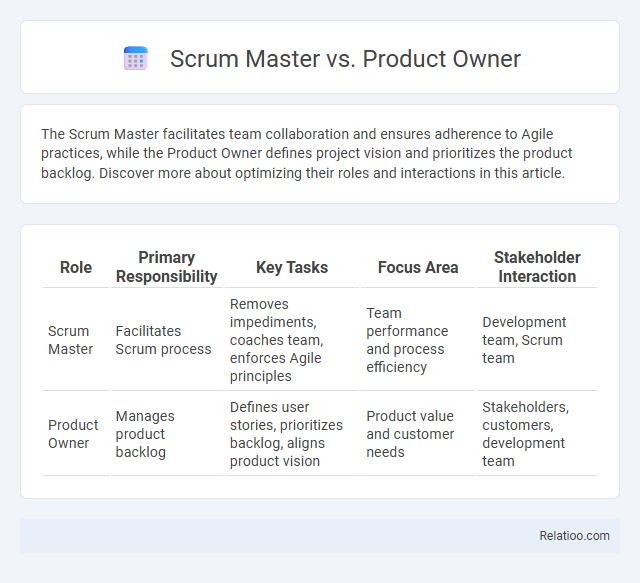The Scrum Master facilitates team collaboration and ensures adherence to Agile practices, while the Product Owner defines project vision and prioritizes the product backlog. Discover more about optimizing their roles and interactions in this article.
Table of Comparison
| Role | Primary Responsibility | Key Tasks | Focus Area | Stakeholder Interaction |
|---|---|---|---|---|
| Scrum Master | Facilitates Scrum process | Removes impediments, coaches team, enforces Agile principles | Team performance and process efficiency | Development team, Scrum team |
| Product Owner | Manages product backlog | Defines user stories, prioritizes backlog, aligns product vision | Product value and customer needs | Stakeholders, customers, development team |
Introduction to Scrum Master and Product Owner Roles
Scrum Master and Product Owner play distinct but complementary roles within Agile project management, essential for successful Scrum implementation. The Scrum Master facilitates team collaboration, removes impediments, and ensures adherence to Scrum practices, while the Product Owner is responsible for defining product vision, managing the backlog, and prioritizing features based on stakeholder needs. Understanding these roles helps you establish clear ground rules that optimize team dynamics and drive project success.
Key Responsibilities of a Scrum Master
The Scrum Master facilitates agile ceremonies, removes impediments, and ensures the Scrum framework is properly followed to enhance team productivity and collaboration. Unlike the Product Owner, who prioritizes the product backlog and defines product vision, the Scrum Master focuses on coaching the team, shielding them from distractions, and fostering continuous improvement. Ground rules in Scrum establish clear behavioral expectations, but the Scrum Master enforces these guidelines to maintain a respectful and efficient team environment.
Essential Duties of a Product Owner
The Product Owner is responsible for defining the product backlog, prioritizing features based on stakeholder value, and ensuring the development team delivers maximum business value. Unlike the Scrum Master who facilitates the process and the team's adherence to agile practices, the Product Owner acts as the liaison between stakeholders and the development team, continuously refining requirements. Ground rules such as clear communication, transparency, and collaboration underpin the Product Owner's role to align expectations and optimize product delivery.
Differences in Daily Activities
Scrum Masters primarily facilitate daily stand-ups, remove impediments, and ensure adherence to Scrum practices, while Product Owners focus on managing the product backlog, prioritizing features, and clarifying requirements for the development team. Ground rules, in contrast, establish the behavioral expectations and team norms that guide daily interactions, communication, and collaboration within Scrum ceremonies. These distinctions shape how Scrum Masters, Product Owners, and ground rules influence team efficiency, accountability, and project progression on a daily basis.
Collaboration and Communication Styles
Scrum Masters facilitate collaboration by removing impediments and fostering transparent communication across teams, ensuring alignment with Agile principles. Product Owners prioritize stakeholder engagement and clarify product vision, using clear and continuous communication to convey requirements and feedback effectively. Ground rules establish consistent communication norms, such as regular stand-ups and active listening, which create a structured environment that supports collaboration and accountability among Scrum roles.
Required Skills and Competencies
Scrum Master requires strong facilitation, conflict resolution, and servant leadership competencies to support the development team and ensure adherence to Agile principles. Product Owner needs exceptional stakeholder management, prioritization, and product vision skills to maximize product value and align with business goals. Understanding and enforcing Ground Rules demands clear communication, accountability, and team collaboration abilities to foster a productive and transparent Agile environment for your project's success.
Influence on Team and Product Outcomes
The Scrum Master facilitates the team's productivity by removing impediments and fostering a collaborative environment, directly influencing how the team functions and adapts to agile processes. The Product Owner drives product outcomes by prioritizing the backlog and ensuring that the team delivers value aligned with stakeholder needs and business goals. Ground rules establish clear expectations and behavior standards, shaping team dynamics and accountability, which ultimately support both effective collaboration and successful product delivery for your project.
Career Pathways for Scrum Masters vs Product Owners
Scrum Masters typically follow a career pathway that advances from facilitating Agile teams to becoming Agile coaches or enterprise Scrum consultants, emphasizing servant leadership and process optimization. Product Owners focus on evolving their skills in product management, market analysis, and stakeholder engagement, often progressing towards roles like Product Managers or Heads of Product. Understanding these distinct career trajectories helps you align your professional development with your strengths in team facilitation or product strategy.
Common Challenges Faced by Each Role
Scrum Masters often struggle with overcoming resistance to Agile adoption and facilitating effective team communication, while Product Owners face challenges in prioritizing backlogs and managing stakeholder expectations. Ground rules frequently become a source of conflict when teams have unclear or inconsistently enforced guidelines that hinder collaboration and accountability. Clear role definitions and transparent communication protocols are essential to address these common challenges and ensure cohesive Agile teamwork.
Choosing the Right Role for Your Agile Journey
Choosing the right role in your Agile journey depends on understanding the core responsibilities: Scrum Master facilitates team processes and removes obstacles, Product Owner prioritizes the product backlog and defines vision, and Ground rules establish behavioral expectations to ensure effective collaboration. Your decision should align with your skills and interests--whether you thrive in coaching and process improvement as a Scrum Master, or in strategic product management as a Product Owner. Mastering ground rules enhances team dynamics regardless of role, driving successful Agile implementation and delivering value efficiently.

Infographic: Scrum Master vs Product Owner
 relatioo.com
relatioo.com